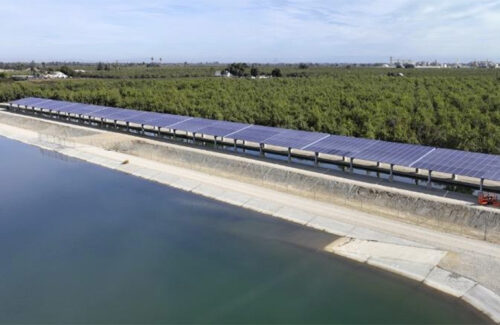
Recent construction of solar arrays over a narrow canal at the site of
Turlock Irrigation District’s Ceres Innovation Center (under development). Credit: TID
An initiative led by faculty from seven top research universities — six of which are in California — aims to accelerate the deployment of solar arrays over the state’s extensive canal network. According to a 2021 UC Merced study published in Nature Sustainability, covering large sections of the state’s 4,000 miles of canals with solar panels could help conserve water, reduce air pollution, save land and generate clean energy using existing land and infrastructure.
The California Solar Canal Initiative (CSCI) research project aims to accelerate the deployment of solar canals across the state by equipping government agencies, utilities, community members and other interested parties with data on optimal locations and identifying willing host communities.
Led by the University of Southern California (USC) Dornsife Public Exchange and independent advisory Solar AquaGrid, CSCI researchers will closely collaborate with the state agencies responsible for water, land and energy: California Department of Water Resources (DWR), California Natural Resource Agency (CNRA) and California Energy Commission (CEC).
“California is leading the way in exploring innovative solutions to tackle climate change and strengthen our water and energy resilience,” said CNRA Secretary Wade Crowfoot. “We are excited to see top research institutions come together to help deploy solar panels over water canals — a big idea with great potential. Science-driven collaborations like this one are critical to guide our path forward.”
CSCI researchers will evaluate solar canals’ potential to:
- Address the needs of a rapidly changing energy market;
- Through co-benefits, be competitive with other distributed-solar projects;
- Enhance current canal operations and maintenance procedures;
- Navigate existing water and land regulations; and
- Provide numerous benefits to communities where projects are developed.
USC Dornsife Public Exchange has assembled a multidisciplinary research team from faculty at seven universities: USC, UC Merced, UC Berkeley, UC Irvine, UC Law San Francisco, San Jose State University and the University of Kansas.
The CSCI research is being guided by an Advisory Council of experts from government, academia, and the private sector to ensure that its outcomes are actionable. The Advisory Council, chaired by Solar AquaGrid, includes members from DWR, CNRA, CEC, California Forward, New Energy Nexus, Environmental Policy Center and Stanford Water in the West.
The potential of solar canals
While not all canals are suitable for solar installations, the UC Merced study estimated that covering all 4,000 miles of California’s exposed canals with solar panels could:
- Generate enough electricity to power about 2 million homes each year;
- Conserve enough water to meet the residential needs of up to 2 million people annually; and
- Reduce land use by up to 50,000 acres by placing solar arrays on existing infrastructure. The study also indicated that covering significant portions of canals could provide benefits beyond power and water, including:
- Lowering maintenance costs by shading the canals, which reduces weed growth in the canals;
- Enhancing the efficiency of the solar panels due to the cooling effect of the water below; and
- Creating local jobs to install and maintain the systems.
Although California experienced multiple episodes of intense rainfall and flooding emergencies in the past two years, scientists predict the state will continue to swing between intense rainfall and prolonged droughts. Droughts have plagued the state for thousands of years, but they are worsened by climate change, emphasizing the continued need to conserve water and reduce greenhouse gas emissions while meeting the state’s increasing energy needs.
Next step in state’s commitment to renewable energy and land conservation
CSCI represents a next step in the state’s commitment to exploring solar canal deployment to meet its 2045 clean energy goals and 30×30 conservation commitment. Those goals led to the creation of Project Nexus in 2023, the state’s first solar canal pilot project currently under construction in the Central Valley. The pilot is funded by the state of California and is a public- private-academic partnership between Turlock Irrigation District, Solar AquaGrid, UC Merced and the CA Department of Water Resources.
News item from USC Dornsife Public Exchange


















